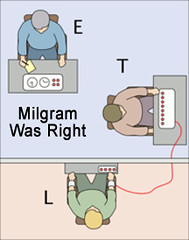The most recent sex scandal to shake up government was General David Petraeus. And this story, like many that have come before it, has some public relations professionals asking questions. Specifically, they wonder if the time has come to rewrite the public relations rules for sex scandals.
Not everyone thinks so. Some people are starting to wonder whether public relations professionals are biting off more than they can chew to become de facto organizational ethics coaches. As James Savage points out in his guest post on Communication Ammo, reputation management might not even be within the purvue of public relations.
As Savage quotes risk management expert Dr. Thomas Kaiser: "The role of PR department is essential for 'clean-up' operations following a reputational risk (sic) event, but they should not be key in its active management. Reputational risk is not a PR exercise — the underlying problems of any event need to be solved rather than actively managed after the event."
Kaiser is mostly right. Public relations professionals might face certain risks associated with their field, but they aren't in the business of risk management. However, I do think it is within the purview of public relations to predict consequences, thereby providing counsel to organizational leaders and implementing a plan to serve the organization and public interest.
As noted before, there is a very clear difference between disaster planning and managing public relations related to disaster planning. While some public relations professionals might be knowledgeable enough to address ethics, reputation and disaster management, the doing is different than the talking. When it comes to Petraeus specifically, there is another question that needs to be asked.
Who does the public relations professional serve again?
If public relations is serving the organization and public interest, there isn't much to be done about Gen. Petraeus. To date, in fact, I have never read a definition of public relations that suggested they serve the organization, public interest, and anyone within the organization that has a lapse of good judgement or character flaw.
Other than ensuring the public that there was no breach in security or mitigating any damage because there was a breach in security, the CIA (while perhaps embarrassed) doesn't owe anything to their former head. He obviously wasn't representing the agency when he engaged in the private affair.
In other words, Gen. Petraeus, not public relations, will have to mitigate his own wrongdoings. And even if he did hire a public relations practitioner to communicate this mitigation, they might offer insight into how the public might respond to any specific actions. Otherwise, that's about it.
Sure, there are times when a public relations professional might be called in some time after a mess has occurred but before it is broken to the public. But the ethical viewpoint is pretty clear, especially because public relations professionals do not have attorney-client privilege.
Ethics isn't confined to a single profession. It's for everyone.
When someone brings something wrong to your attention, you tell them it is wrong, refuse to participate or aid in covering up the wrongdoing, and demand immediate correction. Unless public safety is at risk, it is usually advised that the wrongdoer is given the opportunity to correct it on their own, with the understanding that the person they have attempted to being into their confidence will move to correct the problem if the wrongdoer does not. That's not public relations. It's ethics.
I might add that Brad Phillips is right about one thing. The pat crisis plan for sex scandals has worn thin. The public is growing weary of the "admit it, apologize for it, demonstrate remorse, and promise to never do it again" battle plan. That only works for the individual.
As Phillips points out, Newt Gingrich had a better answer. I don't mean it's something to duplicate. I only mean it was true for Gingrich. So maybe that is the best lesson at all. You have to be true to yourself before you can be true to others.
Not everyone thinks so. Some people are starting to wonder whether public relations professionals are biting off more than they can chew to become de facto organizational ethics coaches. As James Savage points out in his guest post on Communication Ammo, reputation management might not even be within the purvue of public relations.
As Savage quotes risk management expert Dr. Thomas Kaiser: "The role of PR department is essential for 'clean-up' operations following a reputational risk (sic) event, but they should not be key in its active management. Reputational risk is not a PR exercise — the underlying problems of any event need to be solved rather than actively managed after the event."
Kaiser is mostly right. Public relations professionals might face certain risks associated with their field, but they aren't in the business of risk management. However, I do think it is within the purview of public relations to predict consequences, thereby providing counsel to organizational leaders and implementing a plan to serve the organization and public interest.
As noted before, there is a very clear difference between disaster planning and managing public relations related to disaster planning. While some public relations professionals might be knowledgeable enough to address ethics, reputation and disaster management, the doing is different than the talking. When it comes to Petraeus specifically, there is another question that needs to be asked.
Who does the public relations professional serve again?
If public relations is serving the organization and public interest, there isn't much to be done about Gen. Petraeus. To date, in fact, I have never read a definition of public relations that suggested they serve the organization, public interest, and anyone within the organization that has a lapse of good judgement or character flaw.
Other than ensuring the public that there was no breach in security or mitigating any damage because there was a breach in security, the CIA (while perhaps embarrassed) doesn't owe anything to their former head. He obviously wasn't representing the agency when he engaged in the private affair.
In other words, Gen. Petraeus, not public relations, will have to mitigate his own wrongdoings. And even if he did hire a public relations practitioner to communicate this mitigation, they might offer insight into how the public might respond to any specific actions. Otherwise, that's about it.
Sure, there are times when a public relations professional might be called in some time after a mess has occurred but before it is broken to the public. But the ethical viewpoint is pretty clear, especially because public relations professionals do not have attorney-client privilege.
Ethics isn't confined to a single profession. It's for everyone.
When someone brings something wrong to your attention, you tell them it is wrong, refuse to participate or aid in covering up the wrongdoing, and demand immediate correction. Unless public safety is at risk, it is usually advised that the wrongdoer is given the opportunity to correct it on their own, with the understanding that the person they have attempted to being into their confidence will move to correct the problem if the wrongdoer does not. That's not public relations. It's ethics.
I might add that Brad Phillips is right about one thing. The pat crisis plan for sex scandals has worn thin. The public is growing weary of the "admit it, apologize for it, demonstrate remorse, and promise to never do it again" battle plan. That only works for the individual.
As Phillips points out, Newt Gingrich had a better answer. I don't mean it's something to duplicate. I only mean it was true for Gingrich. So maybe that is the best lesson at all. You have to be true to yourself before you can be true to others.



































